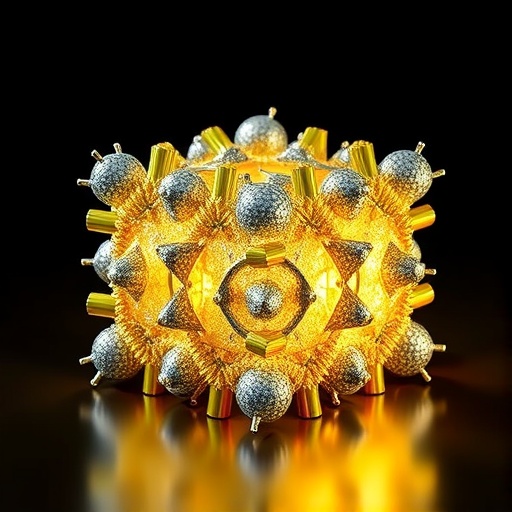In the evolving landscape of energy storage technologies, supercapacitors stand out for their exceptional power density, remarkable cycle life, and rapid charge-discharge capabilities. Recent advancements in this field have unveiled innovative approaches to boost the performance of asymmetric supercapacitors, particularly through the integration of novel materials and doping strategies. The work of Han and Fang illustrates the intricate relationship between material composition and electrochemical performance, shedding light on a new paradigm in asymmetric supercapacitor design.
At the heart of this research is the development of a rod-like manganese molybdate (MnMoO4) positive electrode that presents a notable profile for energy storage applications. The authors have intricately designed this electrode to optimize its electrochemical characteristics. MnMoO4, due to its unique structure, provides an ideal environment for charge storage and transport, which is the cornerstone of effective supercapacitor functionality. The rod-like morphology enhances the surface area, allowing for a greater interaction with the electrolyte and ultimately translating into higher energy storage capacities.
An interesting aspect of the study is the Ni doping process utilized on the MnMoO4 electrode. Nickel ions introduce oxygen vacancies in the crystal lattice, a modification that significantly enhances the electrical conductivity and electrochemical activity of the electrode material. These vacancies not only facilitate ion movement but also optimize charge transfer kinetics during the electrochemical processes. In turn, this bolstered conductivity leads to improved performance metrics for the supercapacitor, particularly in terms of energy density and efficiency.
Complementing the positive electrode is the modified carbon nanotubes (CNTs) negative electrode. CNTs are well-known for their exceptional electronic properties and surface area, making them a prime candidate for negative electrode applications. The researchers modified these CNTs to further enhance their electrochemical performance by increasing their active site availability. This modification is crucial, as it allows for faster electron transfer and ion diffusion, which are vital for achieving high power performance in supercapacitors.
The synergy created by the combination of the Ni-doped MnMoO4 positive electrode and modified CNTs as the negative electrode manifests in the high-performance metrics of the asymmetric supercapacitor. By interlocking the strengths of both electrodes, the device showcases significantly improved energy and power densities compared to conventional designs. This synergistic effect is the result of optimized charge distribution and improved conductivity, setting a new benchmark for future asymmetric supercapacitor developments.
Furthermore, the researchers performed extensive electrochemical assessments, including cyclic voltammetry, galvanostatic charge-discharge tests, and electrochemical impedance spectroscopy. These methods provide valuable insights into the dynamic behavior of the supercapacitor under different operational conditions. The cyclic voltammetry results illustrate the rapid charge-discharge capabilities of the device, indicative of its potential for real-world applications where quick energy delivery is crucial.
The research also touches on the importance of stability and longevity in energy storage systems. The authors reported impressive cycling stability, with the supercapacitor maintaining a high percentage of its initial capacitance even after thousands of cycles. This stability is essential for practical applications, as it signifies that the supercapacitor can endure extensive use without significant degradation of performance.
Looking forward, the implications of this study stretch beyond just the immediate applications of MnMoO4 and CNTs. The insights gained from the relationship between doping and electrochemical performance can guide future research into other novel materials and composite systems. By further exploring different doping elements and combinations of materials, scientists can refine the architecture of energy storage devices even further, leading to the next generation of energy systems.
As energy demands continue to rise globally, the quest for high-performance supercapacitors remains more critical than ever. The advancements showcased by Han and Fang serve as a crucial step towards meeting the challenges posed by the rapidly advancing landscape of renewable energy technologies. Their findings not only reinforce the importance of materials science in energy storage solutions but also inspire further exploration into the creative engineering of future electrodes.
In conclusion, the study by Han and Fang contributes significantly to the field of supercapacitors by presenting a novel approach towards optimizing energy storage devices. The combination of rod-like MnMoO4 with Ni-induced oxygen vacancies and modified CNTs represents a powerful strategy for enhancing supercapacitor performance. As researchers continue to explore additive manufacturing and materials engineering, the potential for discovering new and efficient energy storage solutions remains vast and ripe for innovation.
Through technological advancements such as these, we inch closer to achieving sustainable and efficient energy systems that are crucial for the ever-growing energy needs of our world. The insights revealed in this study not only pave the way for enhanced high-performance asymmetric supercapacitors but also inspire a broader inquiry into the fundamental science of energy storage. These developments mark a pivotal moment in the ongoing quest to make energy storage more efficient, sustainable, and accessible.
In summary, the research conducted by Han and Fang highlights the groundbreaking developments in the field of supercapacitors, demonstrating the significant impact of material modification and innovative design. The future of energy storage is undeniably promising, with continued inquiries in material science poised to unlock new levels of efficiency and performance.
Subject of Research: High-performance asymmetric supercapacitor design using MnMoO4 and modified CNTs.
Article Title: Rod-like MnMoO4 positive electrode with Ni doping-induced oxygen vacancies and modified CNTs negative electrode synergistically constructing a high-performance asymmetric supercapacitor.
Article References:
Han, M., Fang, Q. Rod-like MnMoO4 positive electrode with Ni doping-induced oxygen vacancies and modified CNTs negative electrode synergistically constructing a high-performance asymmetric supercapacitor.
Ionics (2025). https://doi.org/10.1007/s11581-025-06822-z
Image Credits: AI Generated
DOI: https://doi.org/10.1007/s11581-025-06822-z
Keywords: Asymmetric supercapacitor, MnMoO4, Nickel doping, Carbon nanotubes, Energy storage, Electrochemical performance.




